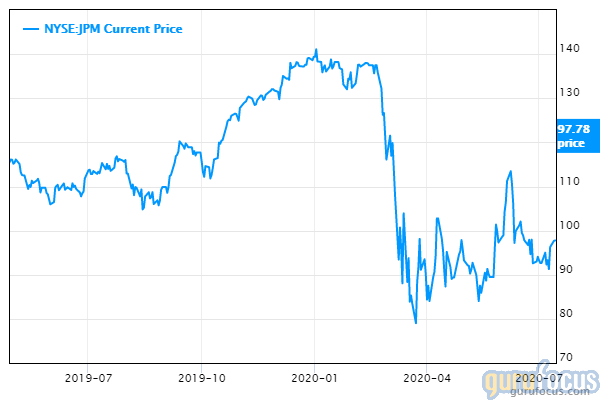JPMorgan: Outperforming as Investors Come to the Rescue
Before the market opened on July 14, JPMorgan Chase & Co. (NYSE:JPM) reported its earnings results for the second quarter of 2020.
The largest U.S. bank by assets posted revenue of $33 billion, up from $28 billion in the prior-year quarter, on earnings per share of $1.38, down from $2.82 in the prior-year quarter. Both results beat analysts' expectations of $30 billion in revenue and $1.04 in earnings per share.
The stock spiked 4% in pre-market trading before settling only marginally above the previous day's close in midday trading.

Overview of the quarter
JPMorgan credited higher income from its investment banking segment and government action with its better-than-expected performance.
The bank ranked number one in global investment banking during the quarter, with fees amounting to 9.8% of wallet share year to date. The return on equity for this segment was an astonishing 27%, while gross investment banking revenue increased 44% compared to the prior-year quarter with a return on equity of 14%. The income from higher trading volumes went a long way toward the company's revenue and earnings beat, despite hits in the traditional banking segment.
For the traditional banking segment, JPMorgan recorded a 2% loss, with deposits up 20%, client investments up 9%, average loans down 7% and credit card sales volume down 23% as customers became more cautious with their spending. The loss was mainly attributed to credit costs of $5.8 billion.
The bank also set aside an additional $8.9 billion in reserves for defaults on loans, or for the forgiveness of loans granted under government stimulus programs. The total provision for credit losses at the quarter's end was $10.5 billion, which is $9.3 billion higher than it was a year ago. Roughly half of the reserve builds are intended for credit card losses.
JPMorgan recorded $1.2 trillion of credit and capital raised for customers year to date, only $28 billion of which went to the forgivable Paycheck Protection Program loans. The vast majority ($651 billion) of capital raised went to corporate clients and non-U.S. government entities, while the majority ($404 billion) of credit went to corporations, while $11 billion in credit went to small business through other loan programs.
The company announced the suspension of share buybacks at least through the third quarter of 2020, though so far its dividend remains steady.
Guidance
JPMorgan did not provide concrete guidance for the third quarter or full year. It did provide rough predictions of interest income ($56 billion) and expenses ($65 billion) for 2020.
CEO Jamie Dimon had the following to say:
"Despite some recent positive macroeconomic data and significant, decisive government action, we still face much uncertainty regarding the future path of the economy. However, we are prepared for all eventualities as our fortress balance sheet allows us to remain a port in the storm. We ended the quarter with massive loss absorbing capacity - over $34 billion of credit reserves and total liquidity resources of $1.5 trillion, on top of $191 billion of CET1 capital, with significant earnings power that would allow us to absorb even more credit reserves if needed. This is why we can continue to serve all of our stakeholders and to pay our dividend - unless the economic situation deteriorates materially and significantly."
Disclosure: Author owns no shares in any of the stocks mentioned. The mention of stocks in this article does not at any point constitute an investment recommendation. Investors should always conduct their own careful research and/or consult registered investment advisors before taking action in the stock market.
Read more here:
Not a Premium Member of GuruFocus? Sign up for a free 7-day trial here.
This article first appeared on GuruFocus.
